Simulation Study on the Characteristics of Gas Extraction from Coal Seams Based on the Superposition Effect and Hole Placement Method
Abstract
1. Introduction
2. Flow–Solid Coupling Model for Gas Extraction
2.1. Equation for Dynamic Changes in Permeability
2.2. Matrix Pore Gas Diffusion Equation
2.3. Fractured Gas Seepage Characteristics
2.4. Control Equations for the Deformation of Coal Rock Masses
3. Numerical Model and Parameters for Gas Extraction from Cascade Boreholes
3.1. Geometric Models and Boundary Conditions
3.2. Parameter Assignment
4. Analysis of Gas Transport Pattern Simulation Results
4.1. Coal Seam Gas Pressure Variations
4.2. Effective Extraction Radius Simulation
4.3. Study of the Main Stress Distribution in Drilled Holes
4.4. Numerical Simulation of the Superimposed Effect of Multiple Boreholes
4.5. Coal Body Permeability Variation Pattern
4.6. Simulation of Seepage Velocity Patterns
5. Optimization of Hole Layout Considering Superposition Effects
5.1. Extraction Compliance Time
5.2. Optimization of Multi-Row Down-Plunge Drilling
5.3. Numerical Simulation of Square Triangular Layout Holes
5.4. Field Engineering Application
6. Discussion
7. Conclusions
- On the basis of the matrix seepage field of double seepage—diffusion, a coal seam gas–solid coupling model was established in combination with the coal deformation field. Through COMSOL simulation, it can be determined that the gas pressure drop rate decreases continuously with an increase in the extraction time to stabilization, and that the main stress around the borehole redistributes. The variations in seepage velocity show different patterns with time of extraction, and a larger diffusion attenuation coefficient leads to the weakening of the matrix contraction effect as well as an accelerated rate of permeability decline.
- A reasonable hole diameter for drilling is 94 mm, the effective extraction radius, r, is 1.2 m, and the influence radius, R, is 5.9 m. The spacing of holes was studied in the range of 2r < d < R + r. There is a blind extraction zone between adjacent holes due to the superimposed effect of extraction; the pressure between holes decreases with a decrease in the spacing, and the superimposed cross-extraction effect gradually becomes obvious with an increase in time.
- Considering safety and economic factors, and reducing the negative impact of blindly reducing the drill hole spacing, the equilateral triangular extraction method was used for the Dongpang mine. The drill hole spacing was 1.8 m and the drill hole row spacing was 2.1 m, effectively avoiding pressure extraction overlap zones and blind areas between drill holes. After pre-pumping verification on-site, the pressure drop in the observation holes all reached the prescribed level, reducing the risk of coal and gas protrusion and providing a theoretical basis for gas extraction engineering designs.
Author Contributions
Funding
Institutional Review Board Statement
Informed Consent Statement
Data Availability Statement
Conflicts of Interest
References
- Wu, X.; Yin, W.; Wu, C.; Li, Y. Development and validation of a safety attitude scale for coal miners in China. Sustainability 2017, 9, 2165. [Google Scholar] [CrossRef]
- Jiang, F.; Lai, E.; Shan, Y.; Tang, F.; Li, H. A set theory-based model for safety investment and accident control in coal mines. Process Saf. Environ. Prot. 2020, 136, 253–258. [Google Scholar] [CrossRef]
- Zhang, D.; Zhang, M.; Zhang, S.; Wang, Z.; Jin, Y.; Liu, R. Numerical simulation of effective extraction radius of pre-drainage borehole based on coal damage model. Sustainability 2023, 15, 4446. [Google Scholar] [CrossRef]
- Ding, W.L. Research on the Distribution and Change Law of Negative Pressure in the Pre-Pumped Long Borehole of this Coal Seam; Henan Polytechnic University: Jiaozuo, China, 2016. [Google Scholar]
- Zhang, M.; Lin, M.; Zhu, H.; Zhou, D.; Wang, L. An experimental study of the damage characteristics of gas-containing coal under the conditions of different loading and unloading rates. J. Loss Prev. Process Ind. 2018, 55, 338–346. [Google Scholar] [CrossRef]
- Zhou, A.; Wang, K.; Fan, L.; Kiryaeva, T.A. Gas-solid coupling laws for deep high-gas coal seams. Int. J. Min. Sci. Technol. 2017, 27, 675–679. [Google Scholar] [CrossRef]
- Zhou, F.B.; Wang, X.X.; Xia, T.J. A model of safe drainage of coal seam gas. J. China Coal Soc. 2014, 39, 1659–1666. [Google Scholar]
- Liang, B.; Yuan, X.P.; Sun, W.J. Seepage coupling model of in-seam gas extraction and its applications. J. China Univ. Min. Technol. 2014, 43, 208–213. [Google Scholar]
- Li, Z.Q.; Liu, Y.; Xu, Y.P.; Song, D.Y. Gas diffusion mechanism in multi-scale pores of coal particles and new diffusion model of dynamic diffusion coefficient. J. China Coal Soc. 2016, 41, 633–643. [Google Scholar]
- Yue, G.; Liu, H.; Yue, J.; Li, M.; Liang, W. Influence radius of gas extraction borehole in an anisotropic coal seam: Underground in-situ measurement and modeling. Energy Sci. Eng. 2019, 7, 694–709. [Google Scholar] [CrossRef]
- Liu, Q.; Cheng, Y.; Wang, H.; Kong, S.; Dong, J.; Chen, M.; Zhang, H. Numerical assessment of the influences of coal permeability and gas pressure inhomogeneous distributions on gas drainage optimization. J. Nat. Gas Sci. Eng. 2017, 45, 797–811. [Google Scholar] [CrossRef]
- Liu, Q.; Cheng, Y.; Li, W.; Jin, K.; He, T.; Zhao, W. Mathematical model of coupled gas flow and coal deformation process in low-permeability and first mined coal seam. Chin. J. Rock Mech. Eng. 2015, 34, 2749–2758. [Google Scholar]
- Wang, E.; Kong, X.; Hu, S.; Li, Z.; Liu, Q. Multi-scale fractured coal gas–solid coupling model and its applications in engineering projects. Transp. Porous Media 2018, 121, 703–724. [Google Scholar] [CrossRef]
- Tan, Y.; Pan, Z.; Liu, J.; Kang, J.; Zhou, F.; Connell, L.D.; Yang, Y. Experimental study of impact of anisotropy and heterogeneity on gas flow in coal. Part I: Diffusion and adsorption. Fuel 2018, 232, 444–453. [Google Scholar] [CrossRef]
- Zhao, D.; Liu, J.; Pan, J. Study on gas seepage from coal seams in the distance between boreholes for gas extraction. J. Loss Prev. Process Ind. 2018, 54, 266–272. [Google Scholar] [CrossRef]
- Chen, M.; Hosking, L.J.; Sandford, R.J.; Thomas, H.R. Dual porosity modelling of the coupled mechanical response of coal to gas flow and adsorption. Int. J. Coal Geol. 2019, 205, 115–125. [Google Scholar] [CrossRef]
- Qi, L.; Qi, M.; Chen, X. Theoretical analysis of coal seam gas pressure distributionaround drainage hole and its application. China Saf. Sci. J. 2018, 28, 102–108. [Google Scholar]
- Hao, F.C.; Liu, Y.W.; Long, W.C.; Zuo, W.Q. Effective gas extraction radius of different burial depths under creep-seepage coupling. J. China Coal Soc. 2017, 42, 2616–2622. [Google Scholar]
- Guo, X.; Li, K.; Linghu, J.; Li, Y. Numerical study on influencing factors of effective drainage radius of gas. Coal Technol. 2021, 40, 119–122. [Google Scholar]
- Li, S.; Zhang, H.; Fan, C.; Bi, H.; Yang, Z.; Tao, M. A flow-solid coupling model considering matrix methane seepage for coal methane extraction. China Saf. Sci. J. 2018, 28, 114–119. [Google Scholar]
- Li, S.; Zhang, H.; Fan, C.; Tao, M. Coal seam dual media model and its application to the proper interpolation among the boring-holes in gas extraction. J. Saf. Environ. 2018, 18, 1284–1289. [Google Scholar]
- Cheng, C.; Cheng, X.; Yu, R.; Yue, W.; Liu, C. The law of fracture evolution of overlying strata and gas emission in goaf under the influence of mining. Geofluids 2021, 2021, 2752582. [Google Scholar] [CrossRef]
- Xu, C.; Qin, L.; Wang, K.; Sun, H.; Cao, M. Gas seepage laws based on dual porosity and dual permeability: Numerical simulation and coalbed methane extraction practice. Energy Sci. Eng. 2021, 9, 509–519. [Google Scholar] [CrossRef]
- Zou, S.; Xin, S. Effective extraction radius of gas drilling in coal seam. China Saf. Sci. J. 2020, 30, 53–59. [Google Scholar]
- Xu, G.; Zhang, K.W.; Fan, Y.F. Numerical simulation of effective drainage radius and optimization of hole spacing under the influence of stack effect. Min. Saf. Environ. Prot. 2021, 48, 91–96. [Google Scholar]
- Wei, F.; Cheng, P.; Zhang, J.; Du, X. Numerical simulation of effective extraction radius of coal seam drilling. Autom. Ind. Mine 2016, 42, 25–29. [Google Scholar]
- Guo, H.; Tang, H.; Wang, K.; Wu, Y.; Wu, J.; Guan, L.; Xu, C. Application of gas-solid coupling effect in the gas drainage with double boreholes along coal seam. J. Xi’an Univ. Sci. Technol. 2021, 41, 221–229. [Google Scholar]
- Zhao, Y.; Lin, B.; Liu, T. Thermo-hydro-mechanical couplings controlling gas migration in heterogeneous and elastically-deformed coal. Comput. Geotech. 2020, 123, 103570. [Google Scholar] [CrossRef]
- Wei, G.; Lou, Z.; Tao, D.; Jia, T.; Yan, J.; Qin, B. Solid-gas coupling model for gas drainage from boreholes and its application. China Saf. Sci. J. 2017, 27, 75–80. [Google Scholar]
- Zhang, H.; Cheng, Y.; Liu, Q.; Yuan, L.; Dong, J.; Wang, L.; Qi, Y.; Wang, W. A novel in-seam borehole hydraulic flushing gas extraction technology in the heading face: Enhanced permeability mechanism, gas flow characteristics, and application. J. Nat. Gas Sci. Eng. 2017, 46, 498–514. [Google Scholar] [CrossRef]
- Lu, S.; Zhang, Y.; Sa, Z.; Si, S.; Shu, L.; Wang, L. Damage-induced permeability model of coal and its application to gas predrainage in combination of soft coal and hard coal. Energy Sci. Eng. 2019, 7, 1352–1367. [Google Scholar] [CrossRef]
- Zhang, M.; Cui, L.; Hu, W.; Du, J.; Zhang, Z.; Wang, C. Acoustic emission experimental research of the damage characteristics of raw coal under different loading and unloading rates. Shock Vib. 2020, 2020, 9063929. [Google Scholar] [CrossRef]
- Ji, M.; Sun, Z.; Sun, W. A case study on the gas drainage optimization based on the effective borehole spacing in Sima coal mine. Geofluids 2021, 2021, 5510566. [Google Scholar] [CrossRef]
- Hu, S.; Liu, X.; Li, X. Fluid–solid coupling model and simulation of gas-bearing coal for energy security and sustainability. Processes 2020, 8, 254. [Google Scholar] [CrossRef]
- Wu, G.; Jia, S.; Wu, B.; Yang, D. A discussion on analytical and numerical modelling of the land subsidence induced by coal seam gas extraction. Environ. Earth Sci. 2018, 77, 353. [Google Scholar] [CrossRef]
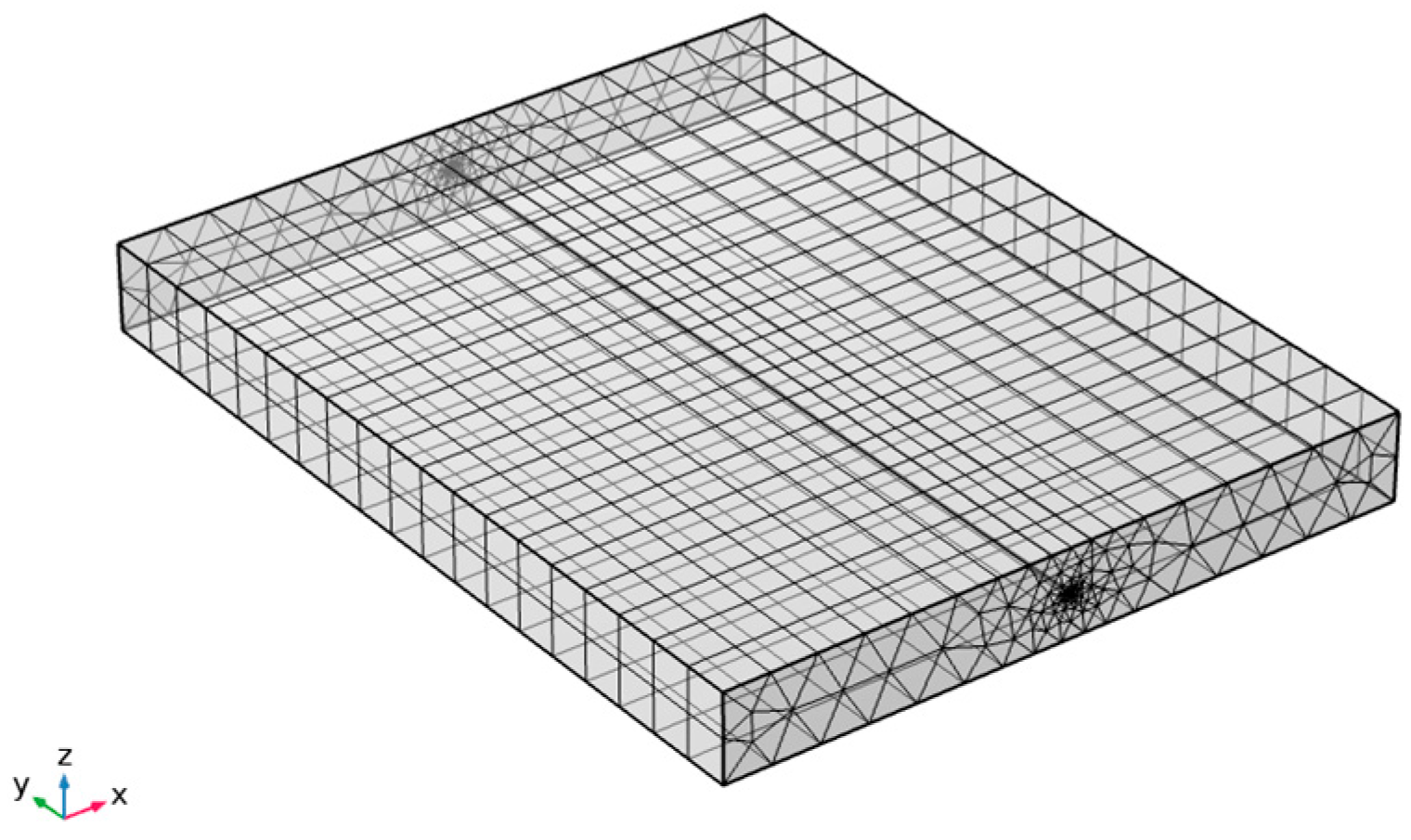


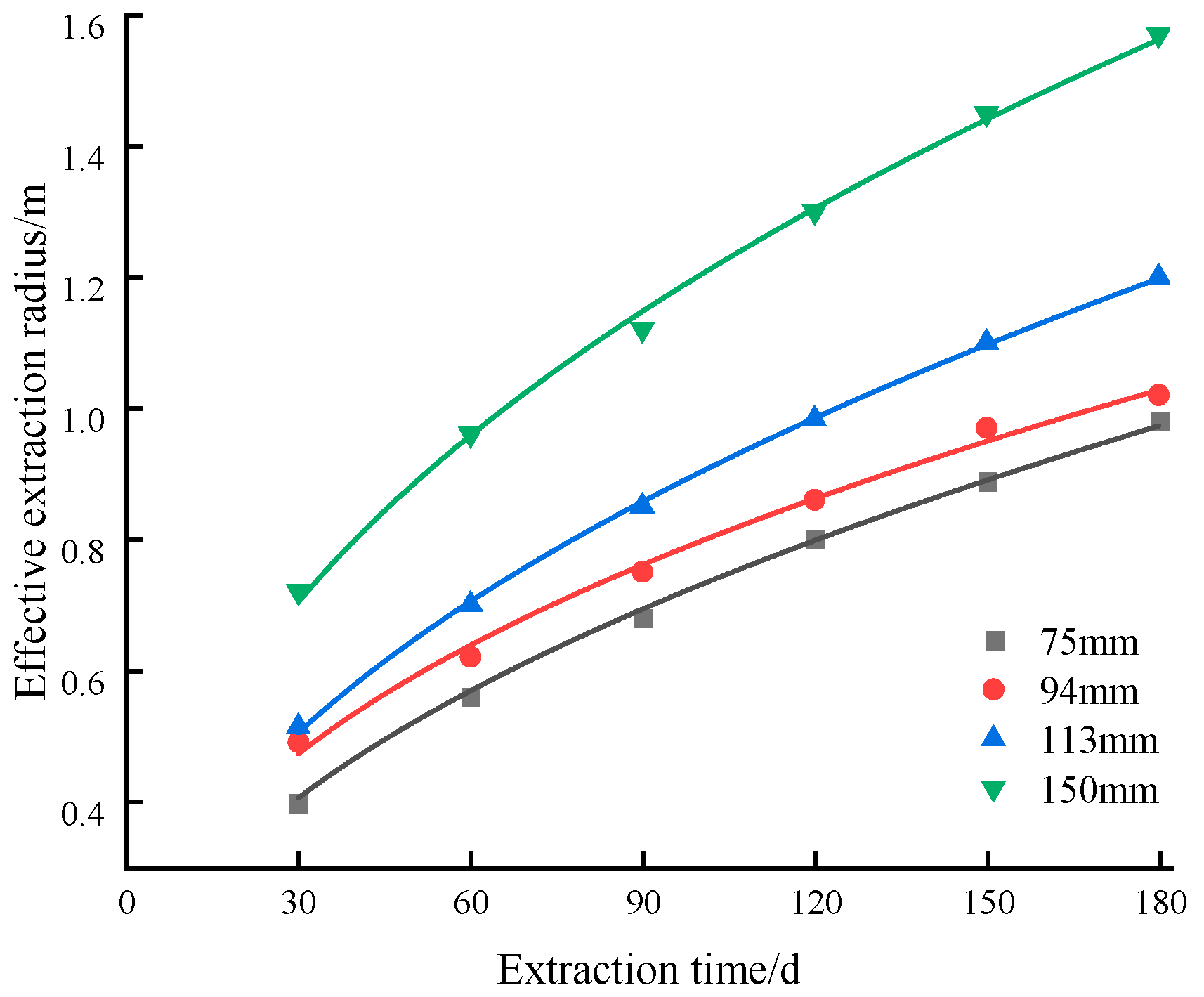




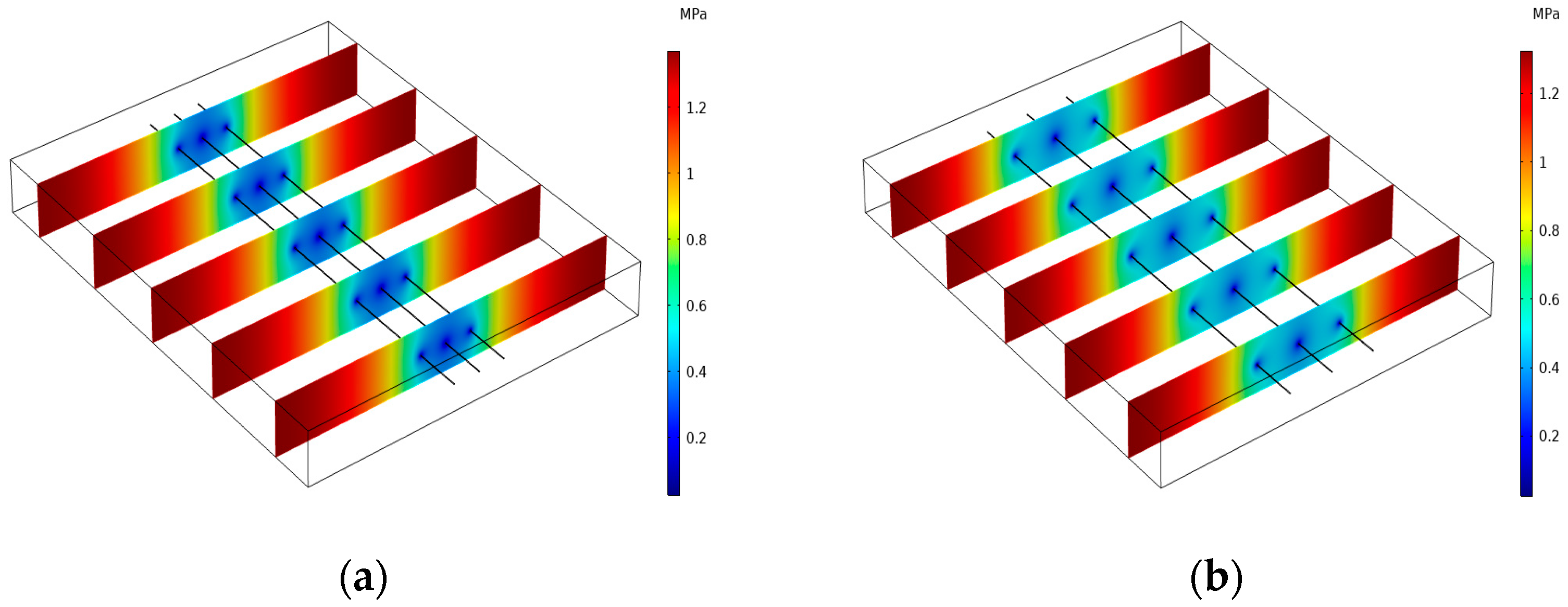
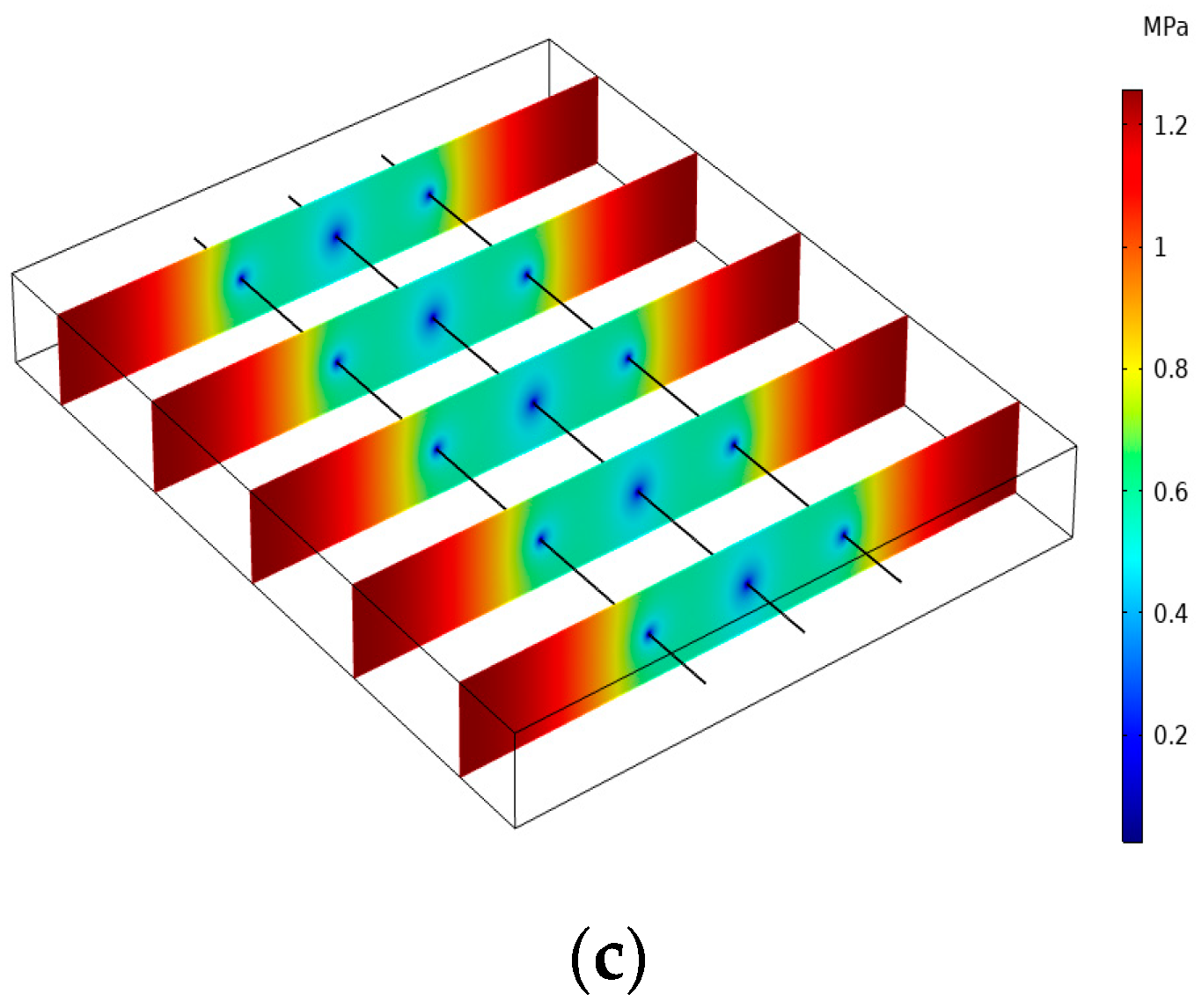
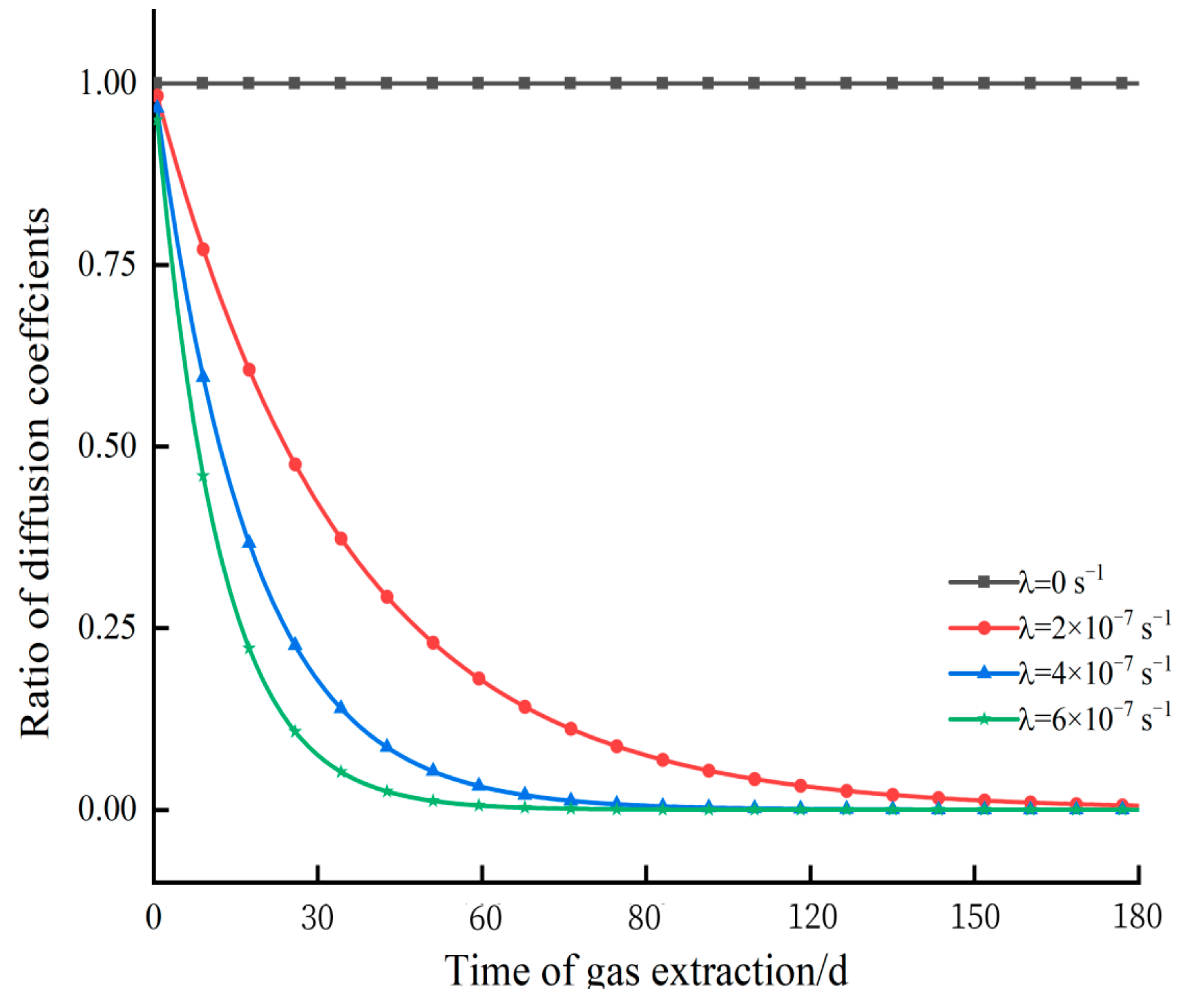


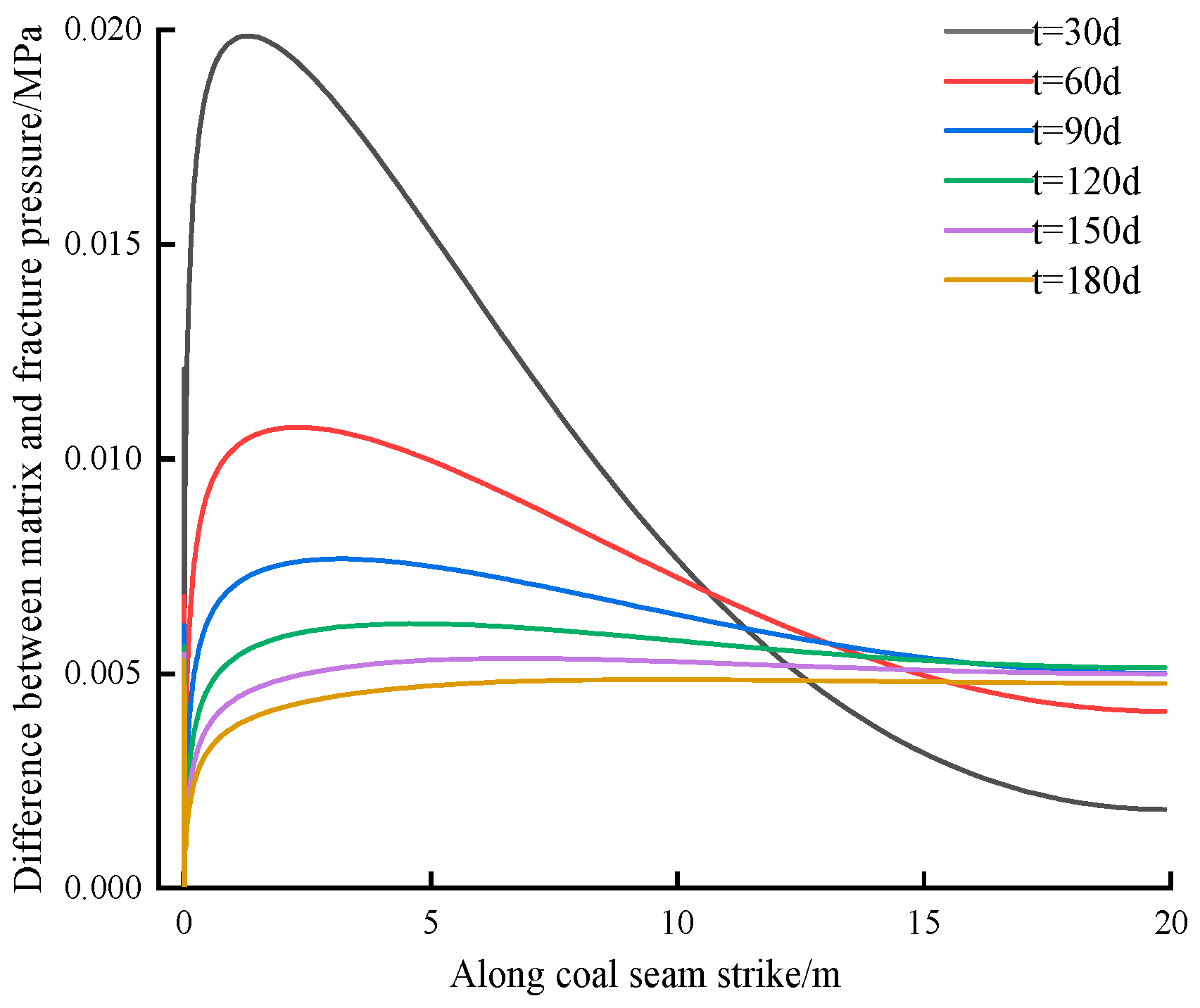

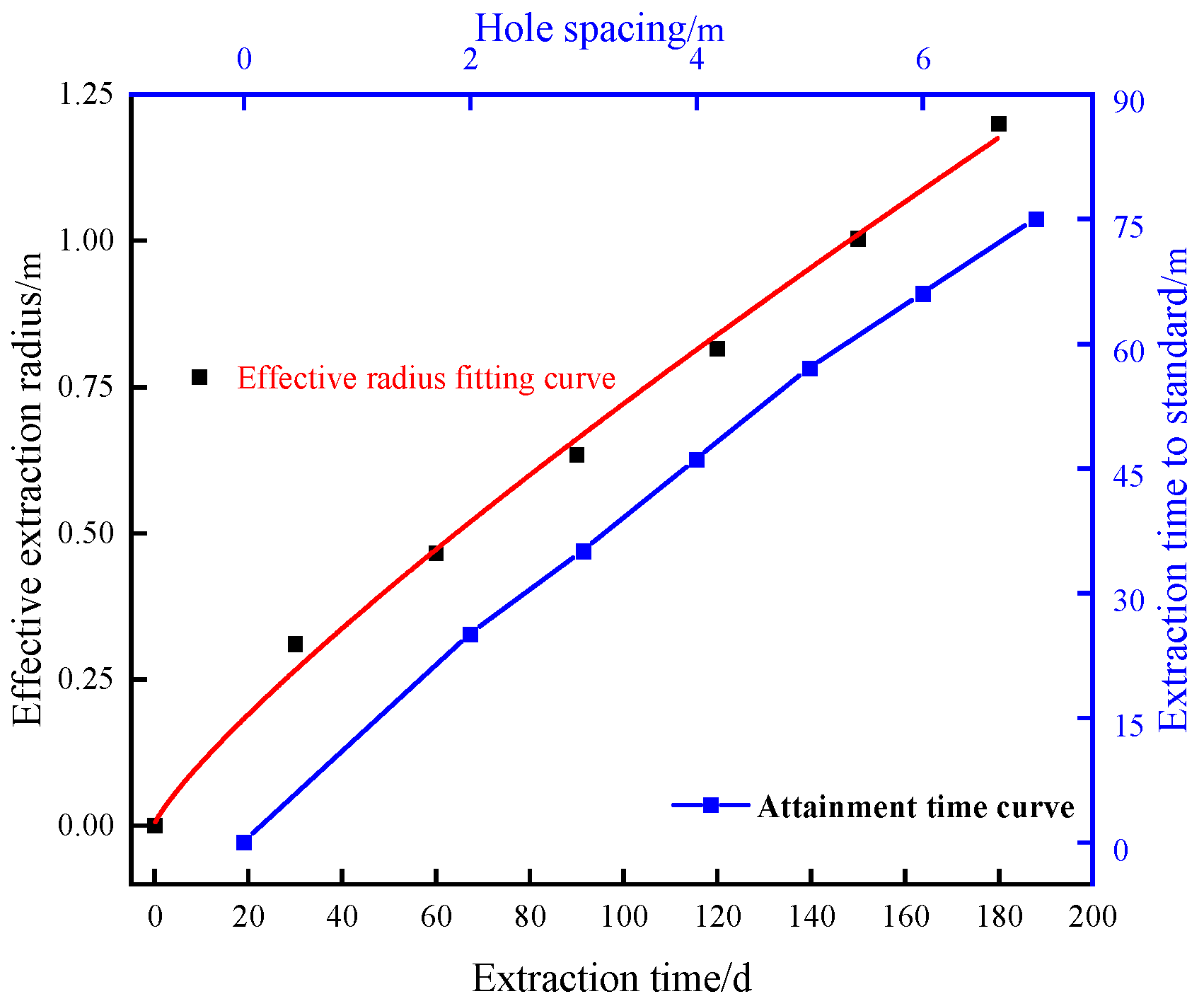





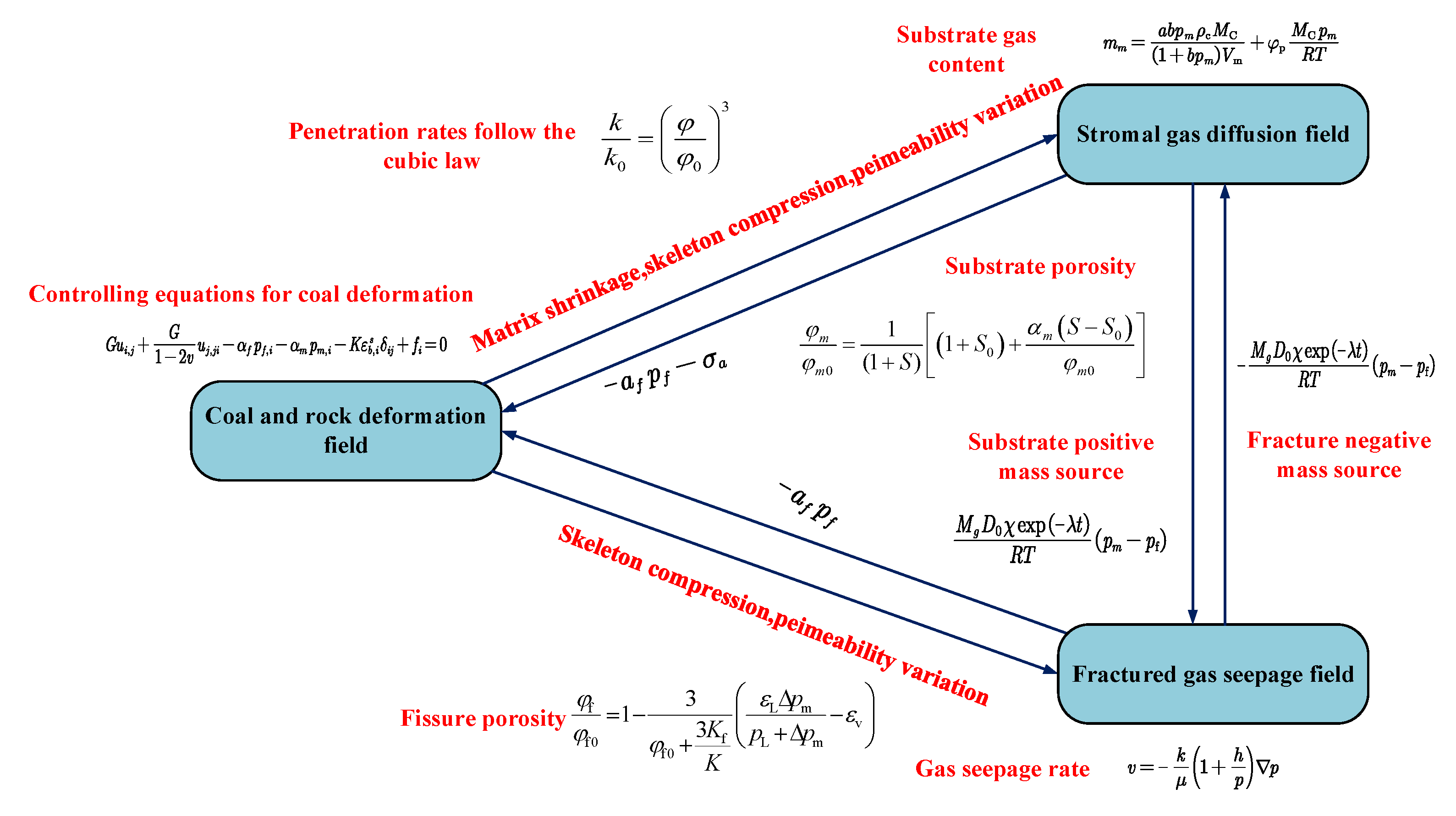
| Parameter Name | Numerical Value | Parameter Name | Numerical Value |
|---|---|---|---|
| Initial substrate permeability, km0/mD | 1 × 10−4 | Langmuir volume product, a/(m3/t) | 28.9 |
| Density of the coal body, ρs /(kg/m3) | 1500 | Extraction negative pressure, pb/kPa | 25 |
| Initial fracture permeability, kf0/mD | 0.1 | Fracture stiffness, K/MPa | 4800 |
| Initial gas diffusion coefficient, D0/(m2/s) | 5.6 × 10−12 | Poisson’s ratio of coal, ν | 0.33 |
| Dynamic viscosity, μ/ Pa·s | 1.34 × 10−5 | Coal skeleton bulk modulus, Ks/GPa | 0.166 |
| Limit adsorption deformation, εL | 0.012 | Modulus of elasticity of coal, E/MPa | 2100 |
| Langmuir pressure, PL/MPa | 0.75 | Initial substrate porosity, φm0 | 0.06 |
| Attenuation coefficient, λ/s−1 | 4 × 10−17 | Initial fracture porosity, φf0 | 0.001 |
| Coal seam temperature, T/K | 315.15 | Klinkenberg factor, Kb/MPa | 0.76 |
Disclaimer/Publisher’s Note: The statements, opinions and data contained in all publications are solely those of the individual author(s) and contributor(s) and not of MDPI and/or the editor(s). MDPI and/or the editor(s) disclaim responsibility for any injury to people or property resulting from any ideas, methods, instructions or products referred to in the content. |
© 2023 by the authors. Licensee MDPI, Basel, Switzerland. This article is an open access article distributed under the terms and conditions of the Creative Commons Attribution (CC BY) license (https://creativecommons.org/licenses/by/4.0/).
Share and Cite
Yan, J.; Zhang, M.; Zhang, W.; Kang, Q. Simulation Study on the Characteristics of Gas Extraction from Coal Seams Based on the Superposition Effect and Hole Placement Method. Sustainability 2023, 15, 8409. https://doi.org/10.3390/su15108409
Yan J, Zhang M, Zhang W, Kang Q. Simulation Study on the Characteristics of Gas Extraction from Coal Seams Based on the Superposition Effect and Hole Placement Method. Sustainability. 2023; 15(10):8409. https://doi.org/10.3390/su15108409
Chicago/Turabian StyleYan, Jin, Minbo Zhang, Weizhong Zhang, and Qinrong Kang. 2023. "Simulation Study on the Characteristics of Gas Extraction from Coal Seams Based on the Superposition Effect and Hole Placement Method" Sustainability 15, no. 10: 8409. https://doi.org/10.3390/su15108409
APA StyleYan, J., Zhang, M., Zhang, W., & Kang, Q. (2023). Simulation Study on the Characteristics of Gas Extraction from Coal Seams Based on the Superposition Effect and Hole Placement Method. Sustainability, 15(10), 8409. https://doi.org/10.3390/su15108409









